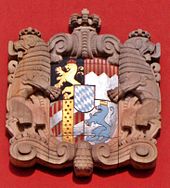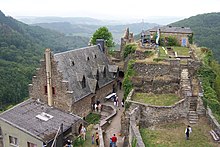George I (Veldenz)
George I of Veldenz (* in the 13th century, † 1347 ) was the reigning Count of Veldenz and royal bailiff in Speyergau .
Origin and family
His father, Count Heinrich I von Hohengeroldseck († 1298), had a second marriage with Agnes von Veldenz, heir to the county of the same name. She was the great niece of Archbishop of Mainz Gerhard I von Dhaun and of Freising Bishop Konrad II ; Well-known cousins of her father Gerlach V. von Veldenz are the Upper German Templar Provincial Master Friedrich Wildgraf von Kyrburg and Bishop Emicho Wildgraf von Kyrburg .
After the male line of the original Veldenz family died out in 1259 and Heinrich I, with his wife as heir, took over the Veldenz government, he called himself Count von Veldenz . His son Georg also bore this gender name, which was taken over from the maternal line.
Georg's brother Walram von Veldenz officiated as Bishop of Speyer from 1328 and died in 1336.
Life
With the death of his father, Georg I took over the government in the county of Veldenz in 1298. The mother had died in 1277. He had the ancestral castle of Veldenz Castle expanded and in 1315 received permission from King Ludwig IV to fortify his village of Meisenheim as well as the award of the Oppenheim city charter for the fortress (based on the legal system of Frankfurt am Main ). Through this and the construction of the castle there, Count Georg I created the basis for the later development of the community as a middle center .
From 1309 at the latest, Georg von Veldenz appears as a royal bailiff in Speyergau, with which he held an important imperial office. In this capacity he resided at Germersheim . The new King Henry VII confirmed him in a document in this office in 1309, but presumably he had already assumed it under his predecessor Albrecht I and kept it until at least 1315. In his certificate of appointment from 1309 he received the condition within one year of construction work worth To make 1200 pounds of Hellern to the Reichsburgen Trifels and Neukastel .
The Veldenzer acted from 1321 as Reichsburg man in Kaiserslautern and received the right of escort there as a castle loan as a reward for his services to the country .
The count had the east palas built at Lichtenberg Castle on the north side of the upper castle with an altar niche facing east. 1345 confirmed him Bishop Heinrich III. of Mainz the foundation of a perpetual mass in the castle chapel, which is supposed to mean the chapel above the entrance gate of the lower castle, consecrated to Our Lady and St. George .
Marriage and offspring
Georg I von Veldenz was married to Agnes von Leiningen , daughter of Count Friedrich IV. Von Leiningen, his predecessor as bailiff in Speyergau and granddaughter of Count Friedrich III. The wife's brother, Emich von Leiningen , officiated 1314-1328 as Bishop of Speyer.

The couple had several children, including the heir son Heinrich II, who was married to Agnes von Sponheim, daughter of Count Simon II von Sponheim . He continued this second Veldenz count family and his great-granddaughter Anna von Veldenz married the Wittelsbacher Stefan von Pfalz-Simmern-Zweibrücken when it went out . This means that the Veldenz family was continued only on the female side, but its old coat of arms, the blue lion on a silver background , later acquired supraregional importance as part of the state coat of arms in the Kingdom of Bavaria .
Another son was Friedrich I , married to Blancheflor († 1358), daughter of Count Johann II of Sponheim-Starkenburg and grandniece (maternal side) of King Rudolf of Habsburg . He resided at Michelsburg , but died on Good Friday 1327, was buried in the provost church of St. Remigius near Haschbach and his grave slab with a full figure is preserved there.
Agnes von Veldenz born von Leiningen died on August 7, 1346, the year of her husband's death, Georg I von Veldenz, is generally given as 1347. Among the Counts of Veldenz, he is one of the most important due to his prominent empire position.
literature
- Karl Roth: Documents of the city of Obermoschel in the former Grafschaft Veldenz , Munich, 1848, p. 5; (Digital scan with short résumé)
- Kurt-Ulrich Jäschke: Regesta imperii: The Regesta of the Empire under Rudolf, Adolf, Albrecht, Heinrich VII, 1273-1313 , Volume 4 of the series, p. 113 u. 114, Böhlau Verlag, 2006, ISBN 3-412-01906-2 ; (Detail scan)
Web links
Individual evidence
- ↑ Website on the history of the county and the Veldenz family
- ↑ German Burgenvereinigung: Burgen und Schlösser , Volume 43, 2002, p. 60 (detail scan)
- ^ Wilhelm Franck: History of the former imperial city Oppenheim am Rhein , publishing house of the historical association for the Grand Duchy of Hesse, Darmstadt 1859, p. 18; (Digital scan on Oppenheim law)
- ↑ Entry in the Rheinische Geschichte portal (under 1315) ( Memento of the original from October 14, 2014 in the Internet Archive ) Info: The archive link was inserted automatically and has not yet been checked. Please check the original and archive link according to the instructions and then remove this notice.
- ^ Georg Bärsch: The Moselle stream from Metz to Coblenz: a geographical-historical-statistical-topographical handbook for travelers and locals , Trier, 1841, p. 277; (Digital scan)
- ^ C. Mehlis: Mitteilungen des Historisches Verein der Pfalz , Volume VII., Speyer 1878, p. 5; (Digital scan)
- ^ Document proposal of December 21, 1321
- ^ Website on Lichtenberg Castle
- ^ Genealogical page on Agnes von Sponheim
| personal data | |
|---|---|
| SURNAME | George I. |
| ALTERNATIVE NAMES | George I of Veldenz |
| BRIEF DESCRIPTION | Count von Veldenz and royal governor |
| DATE OF BIRTH | 13th Century |
| DATE OF DEATH | 1347 |

